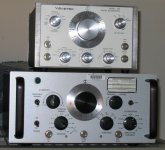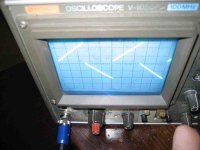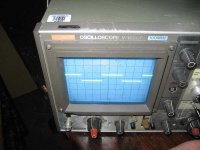A soundcard has its uses, but I have to agree with EC8010 and Tubelab that, for general frequency response measurement and square wave testing, a decent stand-alone, wideband function generator is most useful. In the US, the many Wavetek models have been favorites for decades. You can find these used on on-line auctions or at swap meets, often for well under $50. The picture shows two that I bought at a hamfest for dirt-cheap. The upper unit is a Wavetek 134, whose frequency range goes from <0.2Hz to 2MHz. The lower unit is a US Air Force version of another standard Wavetek model (142?), going from 0.001Hz to 10MHz. You want something that ranges into the low MHz region to give you margin for testing the upper end of frequency response, where peaks and dips can signal resonances and instabilities. The advantages of units like these, in addition to the wide frequency range, include nearly perfect square-wave response, dead-flat output amplitude from well below, to well above, the audio range, and marked dials that give you a quite accurate indication of the frequency. Without a good dial, you’ll be tediously counting divisions on a scope to determine frequency, or resorting to another piece of test equipment, a counter, something you wouldn’t ordinarily need in a basic audio lab. Wavetek made many suitable models in the 110-200 model number range. There are other brands too, of course.
Attachments
Thanks for all the advice. I'll be on the lookout for a function generator on eBay soon. In the meantime, I'm awaiting this motherfather.
OK, so it ain't a Cadillac, but the price was right. Now I know that I should have consulted the community first, but this was cheap and staring me in the face, so I pulled the trigger.
Now you may advise as to why I should have never purchased this model or bought from this vendor or paid this much, etc., etc.
Also, some advice on how to find the oscillation in my BV amp using the scope would be welcome. Of course, I'll probably need a function generator...
Kofi
OK, so it ain't a Cadillac, but the price was right. Now I know that I should have consulted the community first, but this was cheap and staring me in the face, so I pulled the trigger.
Now you may advise as to why I should have never purchased this model or bought from this vendor or paid this much, etc., etc.
Also, some advice on how to find the oscillation in my BV amp using the scope would be welcome. Of course, I'll probably need a function generator...
Kofi
We used to use Hitachi scopes in the factory at work. They were very reliable and worked well. Several hundred of them were run continuously for several years with few problems.
I have also purchased equipment from Avitar at local hamfests. The equipment was clearly marked "non functioning" and priced accordingly. Their description was accurate!
I have also purchased equipment from Avitar at local hamfests. The equipment was clearly marked "non functioning" and priced accordingly. Their description was accurate!
I also have a Hitachi but only a 20Mhz one, Bought for about the same price... Nice and simple to use though and the results are believable. I'm a little sceptical of the need for absolute calibration, I use the "5v" O/p and it does a "5v" square wave, close enough for government work. 
So now you have a 'scope you can start probing around, I guess the first thing to do is check the PSU / B+ is clean, at least you dont need any kind of function generator for that. (suitably rated probes though.)
Incidentally whilst musing this, I found a couple of DIY squarewave generators on the internet based on the humble 555 timer. Someone care to venture rubbish they might be?
Andy

So now you have a 'scope you can start probing around, I guess the first thing to do is check the PSU / B+ is clean, at least you dont need any kind of function generator for that. (suitably rated probes though.)
Incidentally whilst musing this, I found a couple of DIY squarewave generators on the internet based on the humble 555 timer. Someone care to venture rubbish they might be?
Andy
Hi Kofi,
I too have used some Hitachi scopes at vary past places of employment (that's a mouthful) and have generally found them to be reliable and easy to use.
I noted the comment that the contacts on front panel controls need cleaning - in many cases the switches are sealed and cannot be cleaned, however I have also found that with regular use they tend to (self) clean up quickly provided they are not excessively worn.
Get some good probes, for tube work both 1X and 10X probes are useful. Here are some that might suit and are pretty inexpensive:
http://www.hififorless.com/categories.php?categoryid=1651&src=10
This probe appears to be very similar (same vendor) as the probes I use at home with my Tek 2245A, and has reasonable performance.
I too have used some Hitachi scopes at vary past places of employment (that's a mouthful) and have generally found them to be reliable and easy to use.
I noted the comment that the contacts on front panel controls need cleaning - in many cases the switches are sealed and cannot be cleaned, however I have also found that with regular use they tend to (self) clean up quickly provided they are not excessively worn.
Get some good probes, for tube work both 1X and 10X probes are useful. Here are some that might suit and are pretty inexpensive:
http://www.hififorless.com/categories.php?categoryid=1651&src=10
This probe appears to be very similar (same vendor) as the probes I use at home with my Tek 2245A, and has reasonable performance.
Alright! Thanks for all the responses!
I am awaiting the scope and two of the probes that you recommended, Kevin. I also downloaded the manual for the V-1050, which is NOT the V-1050F, but I figure its close enough to get me started.
Also, are there any online resources you know of that would help me understand how to calibrate this thing once I get it? The manual for the HP I was considering was pretty detailed on the subject but the Hitachi, not so much.
Any other first-time-oscilloscope-owner advice would be much appreciated.
Oh yeah-- it seems that the installation of the 1.5K grid stoppers in place of the 330Rs was resulted in a noteable reduction in bass and some grainyness in the highs, but I may just be imagining this. Is this normal for an increase in grid stopper value?
Kofi
I am awaiting the scope and two of the probes that you recommended, Kevin. I also downloaded the manual for the V-1050, which is NOT the V-1050F, but I figure its close enough to get me started.
Also, are there any online resources you know of that would help me understand how to calibrate this thing once I get it? The manual for the HP I was considering was pretty detailed on the subject but the Hitachi, not so much.
Any other first-time-oscilloscope-owner advice would be much appreciated.
Oh yeah-- it seems that the installation of the 1.5K grid stoppers in place of the 330Rs was resulted in a noteable reduction in bass and some grainyness in the highs, but I may just be imagining this. Is this normal for an increase in grid stopper value?
Kofi
Is this normal for an increase in grid stopper value?
Unlikely. If a grid stopper is too large, you can actually have a reduction in highs.
Alright! Scope and probes have arrived and everything appears to be in working order!
So I used the self-calibration lug (.5V) to try and test the square wave and it looks like the sort of square wave Picasso would draw. Its not flat-- its angles quite a bit. I looked for any controls that I thought might help to calibrate and nothing doing.
I'm guessing I need to calibrate the actual probe, then? Also, I can get the probe pin to read the the .5V signal, but not the attached alligator clip. So, there's something else I need to do there, right?
I know this is some basic stuff here, but if one of you would stoop so low there'd be an "Alright! Thanks!" in it for you.
Kofi
So I used the self-calibration lug (.5V) to try and test the square wave and it looks like the sort of square wave Picasso would draw. Its not flat-- its angles quite a bit. I looked for any controls that I thought might help to calibrate and nothing doing.
I'm guessing I need to calibrate the actual probe, then? Also, I can get the probe pin to read the the .5V signal, but not the attached alligator clip. So, there's something else I need to do there, right?
I know this is some basic stuff here, but if one of you would stoop so low there'd be an "Alright! Thanks!" in it for you.
Kofi
Alright! Thanks!
I see where the adjustment is necessary to make the edges of the wave flat, but the wave still isn't really a square wave. It goes like this...
|\
| \
| |
...with one leg shorter than the other, then inverts and repeats.
OK, I'll take a picture tomorrow.
Hmmmm... Kofi's not so smart, eh?
Kofi, eh?
I see where the adjustment is necessary to make the edges of the wave flat, but the wave still isn't really a square wave. It goes like this...
|\
| \
| |
...with one leg shorter than the other, then inverts and repeats.
OK, I'll take a picture tomorrow.
Hmmmm... Kofi's not so smart, eh?
Kofi, eh?
Kofi,
to test the scope you could link from the test point to the bnc connector, that'd prove it was the probe or not
I've made some test leads from some crocodile clips and some old network cable (how basic can you get) they seem to work quite well for this purpose.
Heres where I find out I'm lucky the 'scope hasn't gone 'pop'
Andy
to test the scope you could link from the test point to the bnc connector, that'd prove it was the probe or not
I've made some test leads from some crocodile clips and some old network cable (how basic can you get) they seem to work quite well for this purpose.

Heres where I find out I'm lucky the 'scope hasn't gone 'pop'
Andy
Sorry to ask you obvious questions, but are you sure the settings for each channel are exactly the same as the other? Especially, make sure both channels are set for DC coupling, not AC. Are you using the same scope probe, and merely moving it from channel one to channel two? If so, it would appear that something is out of whack.
Sorry to ask you obvious questions...
That's funny. Its me, man. Kofi. There ain't no obvious questions here.
...but are you sure the settings for each channel are exactly the same as the other?
Well, I thought I did, but apparently not. I checked them over and I was able to play with the vertical and horizontal on the "bad" channel and get a dead-on square wave calibrator like they have in the pictures!
Woo hoo!
Of course, I knocked the other channel out of whack while I was doing that...
So, let's say I am able to calibrate this mother eventually. What can I probe with it given that I do not yet own a function generator? I had an oscillation problem in one channel of the Bevois Valley (see earlier posts) which I solved by following your collective advice and installing a larger grid stopper.
Is there a way I can look for the oscillation without a function generator as I can scientifically derive the proper grid stopper value? Any other cool stuff I can take a look at?
Kofi
Cheap way: Build a cheesy little 555 oscillator out of Radio Shack parts, perfboard, and a 9V battery, with a $10 budget. Use a pot at the input of the amp to adjust the level. This will give you excellent square waves and you can easily adjust the frequency and duty cycle. You'll have to capacitively couple the output to get rid of offset, but that's a Radio Shack part, too.
Cheaper way: Use the scope calibrator signal and a coupling cap, along with the same input pot. Fixed frequency, fixed duty cycle, potential grounding problems, but good square waves at near-zero $$$ and time.
Cheaper way: Use the scope calibrator signal and a coupling cap, along with the same input pot. Fixed frequency, fixed duty cycle, potential grounding problems, but good square waves at near-zero $$$ and time.
Kofi Annan said:OK, so I have some pictures for you guys. First, channel one using the calibration square wave on the scope. This one looks bad:
Did you try to calibrate the probe? (small screw-driver-adjustment in the blue plastic-collar of BNC-plug)
Arne K
- Status
- This old topic is closed. If you want to reopen this topic, contact a moderator using the "Report Post" button.
- Home
- Amplifiers
- Tubes / Valves
- Kofi Annan in: "Oscillatin' in the Bevois Valley'"


